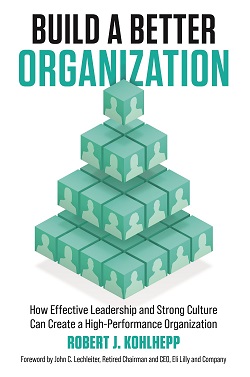
Robert J. Kohlhepp’s new book is titled Build a Better Organization. The succinctness of the title is matched by its thesis statement-like abilities. Kohlhepp cuts through the proverbial foliage and states things in a house style that is direct and to-the-point. To summarize the core theme of his book and subsequent corporate philosophy, success isn’t just a mindset – it’s an attitude. The crux to achieving one’s actualized success lies with approach, as much as it does with what they do.
ABOUT THE AUTHOR: robertkohlhepp.com/books/build-a-better-organization/
What’s interesting about the book is a seasoned reader would expect it to focus on the macro, the building blocks that are wholly tangible and have an A plus B equals C consistency. However surprisingly Kohlhepp, true to the idea of success being a mindset and an attitude, focuses more on the intangible micro. The psychological components of the mindset that will ensure a consistent and fluid execution of one’s goals. This is reflected literarily by how the book is divided into three, distinctive parts. The first is christened Culture, the second People, and the third Leadership. In the first section, Kohlhepp argues one’s clear focus on a principled objective subsequently establishes the spine of one’s endeavor, from the leader’s own work identity traits to the dispatching of management systems.
Naturally this process leads directly into passage two, People, where such solidification ensures one’s hiring is accurate, and singling out is possible for the highest performing members of an employee base. The third part of the book is arguably more ideological, and has less immediacy. It’s essentially a deconstruction and character study of what makes a theoretically ‘great’ leadership profile, spanning nine referential characteristics, to balancing a certain decorum with malleability, to setting certain expectational levels. All of this for the most part is presented in a way that feels completely, thematically harmonious. It’s not an easy thing literarily to pull off. Often people who achieve access to high echelons of influence and power start to shed the necessitated standards held to those climbing the corporate ladders. But Kohlhepp displays a rare humility in this regard, never coming across as lackadaisical with respect to his presentation, nor as overly verbose and intellectually exclusive.
PURCHASE LINK: www.amazon.com/Build-Better-Organization-Leadership-High-Performance/dp/0960109102
These kinds of traits are likely reinforced by his meditations near to the book’s ending, giving us a sense of the man behind the title, the human being behind the achievement and gravitas. “I consider myself very fortunate to have spent 50 years with one company, from which I retired four years ago. When I retired, I asked myself, ‘Now what are you going to do? What are you going to focus on for the rest of your life?’” Kohlhepp writes. “When I pass from this earth and face my maker, I know he’s not going to ask me how many cars or boats I had, how many homes I owned, how many friends I had, or how much money I made. He’s going to ask one question: ‘What have you done for the people you left behind?’…So, since retiring, I’ve spent a fair amount of time thinking about how I could best give back. I believe it’s very important for people like me, who have had wonderful opportunities like I’ve had and learned what I’ve learned, to give back—to give of my time and treasure.” It’s clear Mr. Kohlhepp has never forgotten where he’s started. His advice has all the more heft.
Clay Burton
